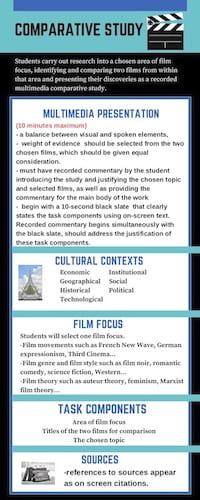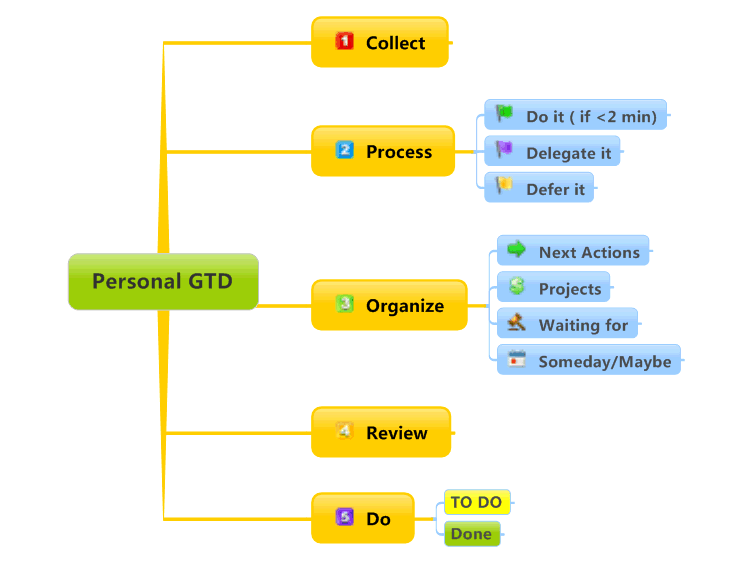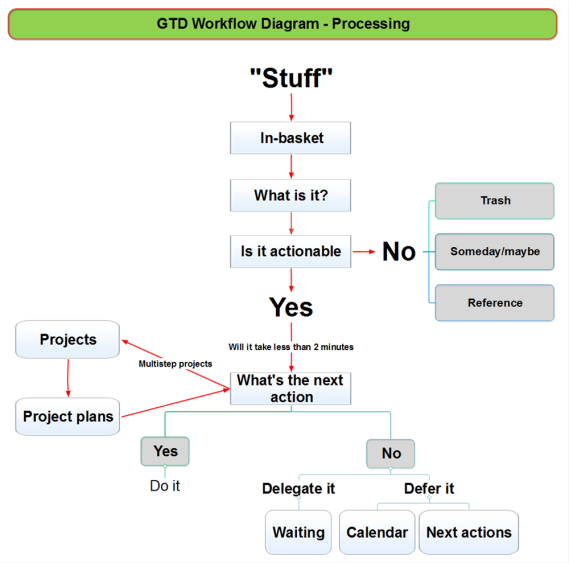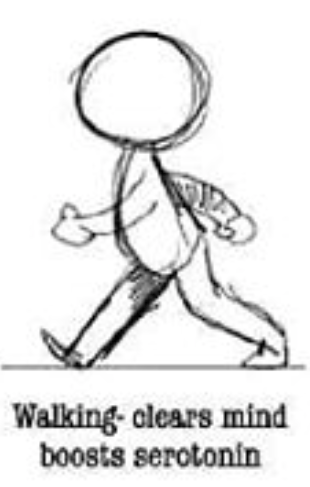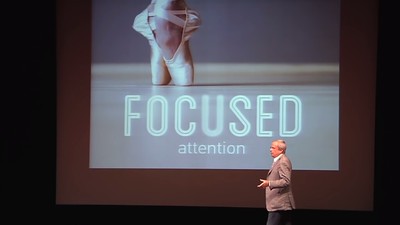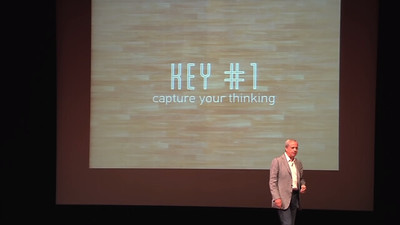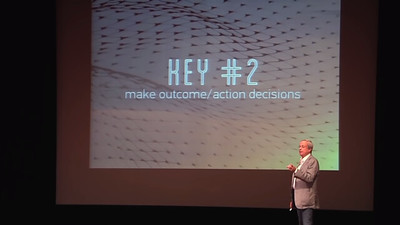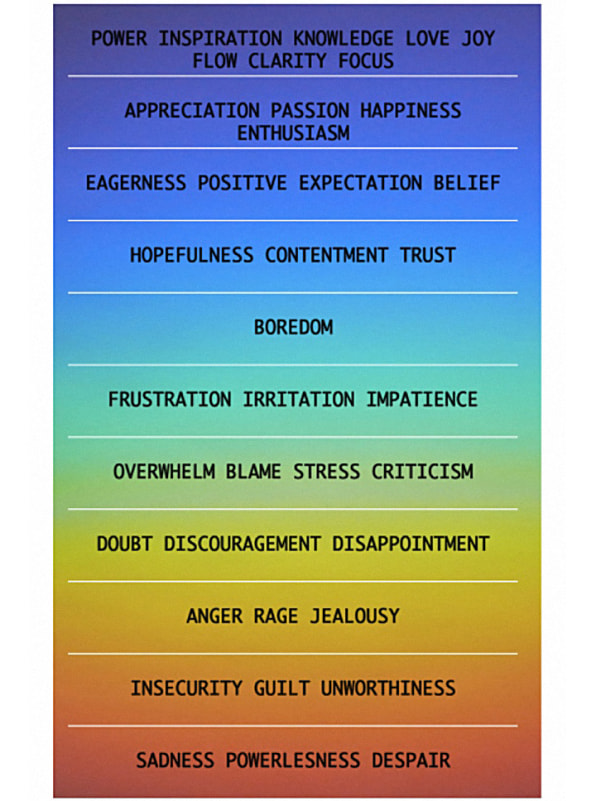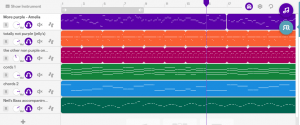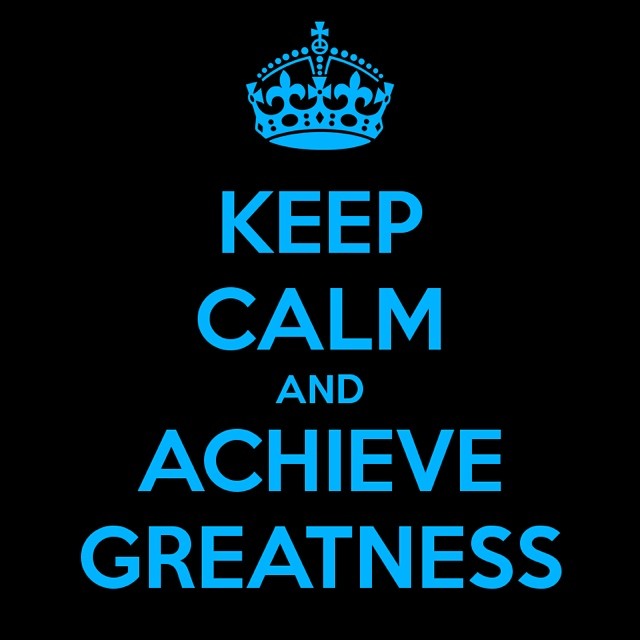- IB Text Analysis: NAME OF FILM

“Director/Conductor” by La Chachalaca Fotografía is licensed under CC BY-NC 2.0
Summary
A guide to planning, researching, and creating your IB Film Text Analysis
- Follow the directions for each step below
- Include for your notes, where required
Student Work
- Justin’s Post, Draft Paper, Bibliography
- Neil’s Post, Draft Paper, Bibliography
- Satchel’s Post, Draft Paper, Bibliography
- Dexter’s Post, Draft Paper, Bibliography
- Sam’s Post, Draft Paper, Bibliography
- Jadee’s Post, Draft Paper, Bibliography
- Laari’s Post, Draft Paper, Bibliography
Guidance for Your Work
“The TA is an exam. Failure to turn in the work within the 4 weeks, unless the teacher requests extenuating circumstances directly from the IB, should be considered a fail.” – IB Film
13.5 Hours To Complete
- Please track how long it took you for each stage
Step 1 – Preparation: Spend 2 Hours
Total Time:
- Watch Mr. Le Duc’s Overview Video (10 minutes)
- Thoroughly read the TA requirements in IB Film Guide PDF (including rubrics) (15 minutes)
- Review the TA Task Details
- Clear cover page with the Title of Film & Timecode (5-minute film extract)
- Sans serif 12 point font
- In-text citations
- List of all sources
- The textual analysis (1,750 words maximum) is intended to be a formalist exercise rather than a thesis-driven
essay. - The focus of the work should be on how meaning is conveyed through the use of film elements in
the chosen film text, with consideration of the cultural context of the film and communicated through the
use of relevant and accurate film vocabulary common to the study of film and appropriate for film analysis. - In this task, the examiner is looking for evidence of the extent to which the student is able to demonstrate an
understanding of:- The cultural context of the chosen film text
- The use of film elements to construct meaning in the selected extract, using appropriate film vocabulary
- How the identified film elements in the selected extract relate to the cultural context of the film, to the film text as a whole and, where appropriate, to other films, as identified by the student
- At the start of the textual analysis, students should clearly state which film elements they are going to
discuss. - The list of all sources used is excluded from the textual analysis word limit
- Read Examples and Scoring Guides (45 minutes)
- Review the Big List of Film Terms (15 minutes)
- Review the Text Analysis Worksheet (PDF) (5 minutes)
- Explore the CHS Library: capital.osd.wednet.edu/academics/library (5 minutes)
- Explore The Moving Image Source Research Guide: www.movingimagesource.us (5 minutes)
- The Moving Image Source Research Guide is a gateway to the best online resources related to film, television, and digital media
- Explore Mr. Le Duc’s Film Resources Page (5 minutes)
- Examine the TA Poster 1 (PDF) (5 minutes)
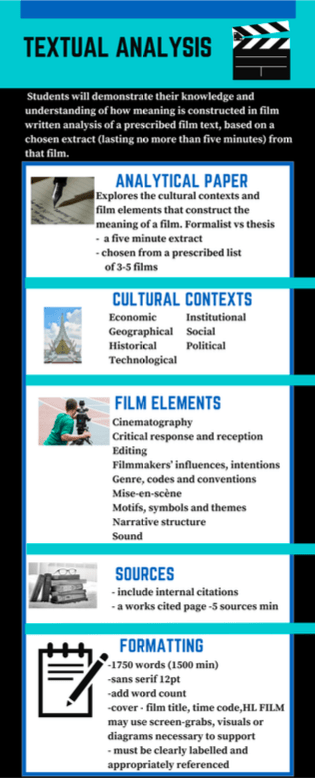
- Examine the TA Poster 2 (PDF) (5 minutes)
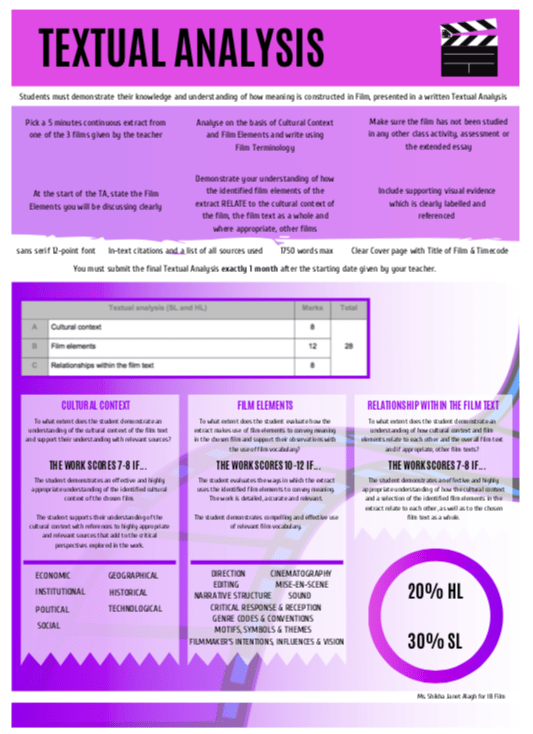
Step 2 – Pick a Film, Watch It, and Write Notes: Spend 4.5 Hours
Total Time:
The goal of IB Film is to expose students to films from all over the world and to increase their critical and practical understanding of film as a creative art form and reflection of its time period, society, and political and cultural environment. As a result, this class requires the viewing of a wide variety of films. In some cases, these films may carry an R rating, or, in the case of films made before 1968 and some foreign films, will have no rating at all. Please be assured that all the films selected for this course have a high degree of artistic merit and that many have won numerous awards and are considered part of the film canon. However, if you object to any film shown that does carry an “R” rating, you will always have the opportunity to request that an alternative film be assigned, and/or be excused from class and not view the film.
- Watch the trailers and pick ONE of these films (or the two episodes) (10 minutes)
- Pan’s Labyrinth [Spain/Mexico] Director Guillermo Del Toro 2006 (Rated R)
- Trailer
- Available on Netflix and other streaming services
- Google Drive (Film and Commentary)
- Across the Universe [USA] Director Julie Taymor 2007 (Rated PG-13)
- Trailer
- Available on Hulu and other streaming services
- Google Drive (Film, Commentary, and Extra Features)
- The Handmaid’s Tale, Season 1 Ep. 01 and 02 [USA] Director Reed Morano 2017 (Rated R – Mature Rating on Hulu)
- Trailer
- Available on Hulu
- Pan’s Labyrinth [Spain/Mexico] Director Guillermo Del Toro 2006 (Rated R)
- Review Drew’s TA Guide Sheet (he scored very high!) (10 minutes)
- First Viewing: Watch the film and record your reactions (2 hours)
- Take notes (below in this post)
- How does the film (various scenes) affect you?
- Remember every scene is like a mini-movie
- Pay attention to which scene best represents the film, for you
- Take notes (below in this post)
- Second Viewing: Notice the cinematography, mise en scene, actor movement, wardrobe, sound (diegetic, non-diegetic, music, etc.) choices (2 hours)
- Review the Big List of Film Terms for cinematic elements, mise en scene (what’s represented on screen), and sound
- Write notes (below in this post)
- This movie greatly effected me emotionally. It highlighted the horrors of facism and the Spanish Civil War.
- The movie is not afraid to show death and violence on screen. The scene where Vidal brutaly stabs the hunter in the face is especially violent.
- The scene where Carman attacks Vidal horrified me. Guillermo del Toro Gómez is not afraid to hold the camera on terrible violence.
- The pale man parallels Vidal and facism. Vidal’s dining room looks like the pale mans.
- The truth of the movie is ambiguous. We do not know if Ofelia was hallucinating or Vidal.
- Film glorifies disobedience
- Fairy tale creatures parallels the war.
- The end scene best represents the film for me.
Step 3 – Choose Your Extract, Watch It, Write Notes, and Research: 2.5 hours
Total Time:
- Open your TA Bibliography Google Doc (In Your IB Google Drive Folder – Mr. Le Duc created)
- You will add your MLA sources as you research
- Choose your 5-minute extract (scene)
- Re-watch this scene numerous times and write notes in the Task Analysis Guide (below) (15 minutes)
- Narrative
- Camerawork: Angles, and Movements
- Composition
- Lens: Depth of Field
- Mise-en-scene
- Blocking / Position of characters
- Acting/body language
- Acting style / method
- Lighting / Cinema Lighting
- Color scheme
- Set/location/props
- Set design
- Costume, hair, makeup, class, gender fabric, color
- Sound Design
- Soundtrack/Score
- Editing
- Research to support your notes (1 hour)
-
- Cultural context Evidence: Textual analysis and sources
- Answer these questions:
- To what extent do you demonstrate an understanding of the cultural context of the film text?
- To what extent do you support your understanding of the cultural context with research from appropriate and relevant sources?
- Answer these questions:
- Cultural context Evidence: Textual analysis and sources
- Add to your notes in the Task Analysis Guide
-
- Re-watch your scene numerous times and add to your notes (15 minutes)
- Research to support your notes (1 hour)
- Re-read Criterion B Film Elements Rubric
- Evidence: Textual analysis and sources
- To what extent do you evaluate how the extract makes use of film elements to convey meaning in the chosen film?
- To what extent do you support your observations with the appropriate use of relevant film vocabulary?
- Evidence: Textual analysis and sources
- Write notes (below in this post)
- 1:45-1:50
- Re-read Criterion B Film Elements Rubric
Step 4 – Compose A Rough Draft: 2 hours
Total Time:
- Watch Mr. Le Duc’s Convert a Table into Text with Editpad.org tutorial and do the following: (5 minutes)
- Copy and paste the two columns of your Text Analysis Guide notes (below) into editpad.org
- This will convert your two-column table layout into a regular text document
- Copy and paste from editpad.org into your Google Docs TA Paper Template
- Copy and paste the two columns of your Text Analysis Guide notes (below) into editpad.org
- Thoroughly re-read and examine your work with the Text Analysis Rubric (PDF) (10 minutes)
- Compose your rough draft (1.75 hours)
- Weave in your research the following
- WHAT: Your observation about a film element in the 5-minute scene
- WHY: Relate the film element to the shot or scene’s emotional or narrative importance
- HOW: Explain how the film element works in the context of this scene
- SO WHAT: Justify it with the cultural context, as needed
Step 5 – Get Draft Peer Reviewed: 30 Minutes
Total Time:
- Get it peer-reviewed with the TA Worksheet (PDF) (30 minutes)
- Peer Reviewer: Look for evidence of each section of the document
- Look for WHAT, WHY, HOW for each statement in the paper
- There should be at least one WHY or HOW or every WHAT statement
- Look for cited research to support statements, where it makes sense
- Write comments to help the author
- Add them as “Add Comments” on the side, so you do not add to the word count of the document
Step 6 – Revise: 1 Hour
Total Time:
- Revise your draft (1 hour)
Step 7 – Get Feedback from Mr. Le Duc and Revise: 30 Minutes
Total Time:
- Get feedback from Mr. Le Duc
- Make final revisions and check format (30 Minutes)
Step 8 – Finalize Paper and Cover Page: 15 Minutes
Total Time:
- Clear cover page with the Title of Film & Timecode (5-minute film extract)
- Sans serif 12 point font
- In-text citations
- Less than 1,750 words maximum
Step 9 – Finalize Bibliography and Check Format: 15 Minutes
Total Time:
- Update your TA Bibliography Google Doc (In Your IB Google Drive Folder)
- Finish and check the format of your MLA sources as you research
Step 10 – Upload to Turnitin.com: 10 Minutes
Total Time:
- Upload your TA paper (from Your IB Google Drive Folder)
- Upload your TA Bibliography Google Doc (from Your IB Google Drive Folder)
Text Analysis Guide (For your 5 Minute Scene)
TASK COMPONENTS (INQUIRY) |
NOTES |
| The extract may be up to five minutes in length and must be a single, continuous sequence of the film | |
| Time of 5-minute clip | 1:46:40 1:51:40 |
PART 1 – The film, your scene, why it is of interest, and how your scene relates to the whole film. |
This is the climax of the film. The scene involves the death of the main character, Ofelia as well as the antagonist of the film, Vidal. Spanish rebels kill Vidal after he kills Ofelia. Ofelia either slips into delusion as she dies or is transported to an underground realm and becomes the princess. |
Brief Summary of ExpositionWriter, Director, Producer, studio, year released Main characters, conflict, identify the genre. Identify the aspect ratio. |
The film was written and directed by Guillermo del Toro Gómez. The producers were Guillermo del Toro, Alfonso Cuarón, Bertha Navarro, Frida Torresblanco, and Álvaro Augustín. |
Context of Extract in Film – briefly describe the sceneAt what times does your scene occur, how it begins, and how it ends. Do not describe it further. The judges have seen the movie. |
This scene is the climax of the film. The scene starts just after Ofelia has been shot by Vidal. Vidal then takes his son back and walks to the entrance to the labyrinth. Cartman and Tarta take the kid from Vidal and shoot him. Carman hums a lullaby to Ofelia as she dies. The scene zooms in on Ofelia and we see her in the underground kingdom becoming the princess. The scene them zooms out and we see Ofelia dying, implies that if could have just been a coping mechanism. |
The Rationale for Selection – relation to the entire movieWhy is it interesting and why does this scene best illustrate the themes of the whole movie? |
This scene illustrates the importance and loss of innocance. Ofelia only got to the underground realm because of her innocence, but she is killed for it. It shows the importance of defiance in the movie. The rebels defied facism, Ofelia defied the faun and the rebels defied Vidal. |
PART 2 – Remember to integrate the Director’s intent with each of the following areas in this section |
|
Narrative |
|
| Script – Not just dialogue but in terms of being the spine of the storyExplain how this scene advances the plot. How do the events of this scene clarify/complicate matters? How does this scene affect/cause future events? What new information is revealed or suggested about a character? Is there anything deliberately withheld? Anything unusual in the dialogue? Word choice? Delivery? Accents? Repetition? | Carman finaly says no to Vidal. She says that she will not tell his son who his father is. This in in contrast to all that Vidal cares about. The foreshadows the decline of facism in Spain |
Cinema Photography |
|
| a) Camerawork – describe shots in specific termsShot size: ELS, LS (stage), full shot, MS, CU, ECU. Camera angles: bird’s eye, high angle, eye level, low angle or Dutch (oblique), camera movement: pan, tilt, dolly or tracking, handheld, Steadycam, or moving crane. Invisible V conspicuous. Are tracking shots motivated by character movement? | |
| b) CompositionOpen/closed composition, aspect ratio, rule of thirds, Kubrick single-point perspective. | This film uses an aspect ratio of 1.85 : 1. This means that the film is widescreen. Open composition. |
| c) Depth of FieldConsider foreground, mid, ground, and background. Deep focus is associated with wide-angle lenses. Could be flat. Narrow ranges of focus may be the result of telephoto lenses. | In the throne room the film uses a shallow depth of field. In the real world it uses a slightly longer one? |
Mise-en-scene – The overall look and feel of a movie |
|
| a) Position of characters and objectsIdentify the dominant, does movement guide our focus, character proxemics patterns (intimate, personal, social, and public distances). How does the director add meaning to these choices? Is one character encroaching on another’s space? Watch for space being used to portray relationships/changes in relationships. Watch for windows, doors, parallel lines that frame people or objects. Entrapment. Look for actor placement. Front – actor facing camera, greatest intimacy. One-Quarter Turn – very popular. Profile – character lost in the moment, a bit more distant than the previous two. Three Quarters Turn – useful to convey anti, socialness, Back of Head, most anonymous shot. Creates a mystery or feeling of alienation. | |
| b) LightingLow or high key. How does the director use light to focus our attention? Key, fill, and backlighting. What is the source of lighting in the context of the scene? | This scene uses low key lighting for the most part. Once Ofelia gets to her kingdom, the movie uses brighter lighting. I believe is is technically high key, but it still doesn’t seem very bright. It shows the contrast between Ofelia’s grim reality and her fantasy. |
| c) Color schemeHow does the director use color and what is the director’s intent for doing so? Look for color symbolism or color associated with characters. Color to suggest a mood. Color as foreshadowing. Contrasting colors ( the monolith v white room) | The real world is very gray and bleak. Ophelia’s fantasy kingdom is golden and bright. The real world is much darker than Ophelia’s fantasy’s |
| d) Set/location/propsSet design. Studio or on, location, describe props, scenery, what was the Director ́s intent for using them? How dense is visual information? Stark, moderate, or highly detailed? | The underground realm seems elegant and the real world seems bleak and sad. The visial information is very detailed. |
| e) Costume, hair, make upPeriod, class, gender (emphasize or diminish), age-appropriate, silhouette (close-fitting or baggy), fabric (plain, sheer, rough, delicate), accessories. Color is very important in relation to character. | Vidal looks like a monster in this scene. He is covered in blood, has stab wounds and he is no longer wearing a military uniform. He has been stabbed because of his cruelty. His emotional cruelty has made him into a metaphorical monster and now he looks like one too. The rebels are all wearing civilian cloths which shows how they dont embody the same facist ideals as their enemies. The faun looks like he is mad eout of nature itself. Ofelia is wearing nice, yet humble cloths in reality, However in her kingdom she wears a dress which shows the contrast between fantast and reality. |
| f) Acting/body languageActing style, body language, blocking, period, or contemporary. Individualized (Joker), Stylization. Look for subtext (character says one thing but means something else). Consider typecasting as a shortcut to characterization. | During this part of the movie, the rebels show strength and determination. Carman finally uses strong body language to finally stand up to vidal. The faun moves in an almost alien like fashion, showing that it is very inhuman. This raises tension in the audience. |
Sound – watch scene w/o pictureLive sound, sound effects, and music. Sound can be diegetic, meaning characters would hear it, or non, diegetic, meaning that characters would not hear it, such as narration or music over the credits. Explore the relationship between diegetic and non, diegetic sound when appropriate. |
The faun sounds like a tree creaking when it walks, showing that it is part of nature. Ophelia is very quiet and calm as she is dying, showing her innocence. After she is supposedly transported to the kingdom, we can still hear her breathing as she is dying. This implies that it is all in her head. |
MusicIs the music telling you what to feel? Music can be used as a counterpoint to the action. |
he music is very calming yet melancholy in the underground kingdom. It shows the bittersweet tone of the scene. She got her happy ending but it may all be in her head. The music is based off of the lullaby that Carman sings to Ophelia. This further implies that the kingdom might be a coping mechanism. |
EditingEllipsis (time compression) and cross-cutting, fades, dissolves (fades between scenes), wipes, matching cuts, straight cuts, dialogue overlap, and sound bridges. Consider how long each shot lasts. |
This scene uses long shots because while the this scene is intense, it is not past paces. The scene uses zoom transitions when switching between the kingdom and the labyrinth to ask the question “Is this all in her head?”. |
Part 3: Analyzing the Film as a Product |
|
Sociocultural ContextIn what way was this movie a product of its time? What does the audience learn about the culture or historical context of the film? |
This movie shows the history of the Spanish Civil War. Director Guillermo Deltoro wanted to capture the emotional weight of the Spanish Civil War in this film. It focuses more on how a young child may have felt during the time. |
Target AudienceTeens/adults or male/female age group, college education art crowd, liberal, conservative, Christian |
Adults. People who are interested in learning about war, Spain or horror. |
Generic Expectationshttp://www.filmsite.org/filmgenres.html also research http://tvtropes.org/pmwiki/pmwiki.php/Main/Tropes |
Fantasy, War, Drama |
ThemesMan V Man, or one of the others, is this film an allegory? |
Allegory for decline of facism. Disobedience is important. Loss of innocence. |
Motifs/SymbolsWhat specific devices support your definition of the theme? Look for recurring elements. |
Flower represents hope. Girl represents the good of the world. Vidal represents facism. |
Film CriticismBoth contemporary and current. Use brief quotes from two different sources. Record the details: reviewers’ names and publication names/dates |
The story is a compelling and deeply involving one, and the film is both beautiful, exciting, and sometimes horrifying. The creature effects are superbly handled.
November 12, 2014
David Stratton.
It’s so audacious and so technically accomplished, and arrives here garlanded with so many radiant superlatives, that I wish I liked it more. November 12, 2014
Peter Bradshaw
|
TASK COMPONENTS (ACTION) |
|
| Compose Paper | |
Part 4: Sources |
|
| Source 1 | |
| Source 2 | |
| Source 3 | |
| Source 4 | |
| Source 5 | |
| Source 6 | |
| Source 7 | |
| Source 8 | |
| Source 9 | |
| Source 10 | |
TASK COMPONENTS (REFLECTION) |
|
| Revision 1 | Proofreader: |
| Revision 2 | Proofreader: |
| Revision 3 | Mr. Le Duc |
External Assessment Criteria SL and HL
Peer Review Checklist
- Use the TA Worksheet (PDF) for review of core elements for the peer review
- Use the TA Marksheet (PDF) for the inclusion of all needed elements in peer review

